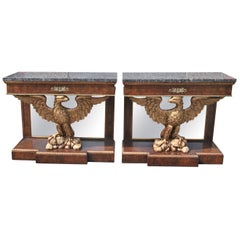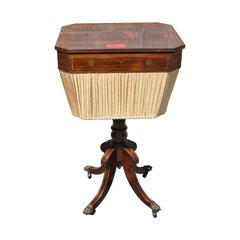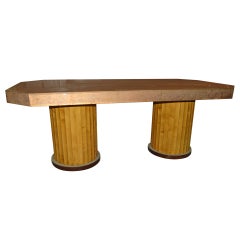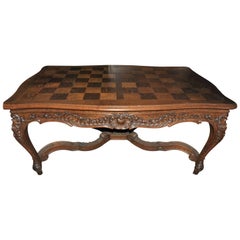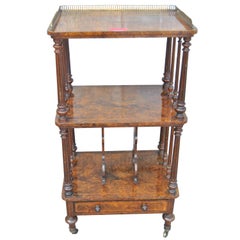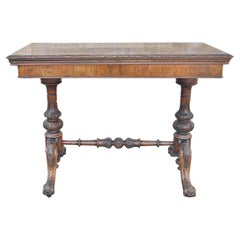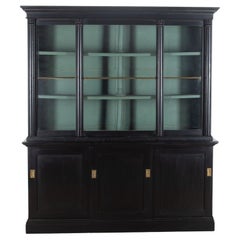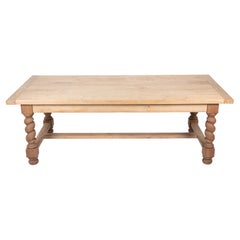Jere's Antiques Inc Tables
to
2
Height
to
Width
to
Depth
to
9
9
3
2
2
1
1
6
3
2
1
1
9
4
3
2
2
9
8
7
1
9
9
9
Pair of English Eagle Based Console Tables, circa 1910
Located in Savannah, GA
This is a matched pair of console / hall tables made in England, circa 1910. The top of each table is a beautiful cut of blue, black and gray highly figured marble. The frame on each...
Category
Early 20th Century English George I Console Tables
Materials
Marble
19th Century Regency / William IV English Rosewood Sewing / Work Table
Located in Savannah, GA
This is a Regency / William IV Rosewood Sewing / Work Table made in England, circa 1825. The table is made of a very fine, beautiful, highly figured cut of Rosewood. The table is rectangular in shape with Chamfered Corners. The top has 2 String...
Category
Antique 1820s English Regency Tables
Materials
Brass
English Crystal Peach Glass Table
Located in Savannah, GA
English glass top table, circa 1950. The glass is sheets of Swavorsky Crystal. This is not ordinary glass as Crystal is absolutely flawless, crystal clear glass. The table is done in a Mottled Peach Glass...
Category
Vintage 1950s British Art Deco Dining Room Tables
Materials
Crystal
$6,000 Sale Price
20% Off
Early 20th Century French Carved Oak Table
Located in Savannah, GA
This is a fabulous quality, very highly carved table made in France, circa 1920. The table has extremely Fine quality carvings throughout. The side...
Category
Early 20th Century French Rococo Dining Room Tables
Materials
Oak
$3,000 Sale Price
20% Off
19th Century English Walnut Canterbury
Located in Savannah, GA
This is a Canterbury or bookcase or 3-stage display or server made in England, circa 1870. The piece is made of Kashmir walnut (the finest cut of Burr Walnut). There is a pierced bra...
Category
Antique 1870s English Victorian Bookcases
Materials
Walnut, Burl
19th Century Walnut / Burr Walnut English Game / Card Table
Located in Savannah, GA
This is a game table made in England, circa 1870. The table is made of walnut and burr walnut. The top has a fabulous quality cut of the finest burr walnut. The 4 sides of the top ar...
Category
Antique 1870s English Victorian Card Tables and Tea Tables
Materials
Walnut, Burl
19th Century Walnut Partners Desk
Located in Savannah, GA
This is a walnut and Kashmir walnut partners desk made in England, circa 1890. The top of the desk is Walnut with 3 shaped pieces of beautiful brown lea...
Category
Antique 1890s English George III Desks
Materials
Walnut
19th Century English Mahogany Drop Leaf Sofa Table
Located in Savannah, GA
This is a solid mahogany drop leaf table made in England, circa 1825. The top, both leaves, the ring turnings on the pedestals, the plat...
Category
Antique 1820s English Regency Sofa Tables
Materials
Ebony, Mahogany
19th Century Rosewood Game, Card Table
Located in Savannah, GA
This is a rosewood game, card table made in England, circa 1850. The top has rounded corners and a nicely molded edge. The top spins open to reveal storage for game pieces, cards, et...
Category
Antique 1850s English Victorian Card Tables and Tea Tables
Materials
Rosewood
Related Items
19th Century English Painted Bookcase
Located in Gloucestershire, GB
19th Century English painted bookcase or display cabinet.
Ebonised with sliding glazed doors on the top and solid sliding doors to the base.
With brass detailing and original glass.
Category
Antique 19th Century English Country Bookcases
Materials
Wood
Early 20th Century French Farmhouse Dinning Table
Located in Austin, TX
This Early 20th Century French Farmhouse Dining Table is a stunning example of rustic elegance, perfect for adding a touch of French countryside charm to any home. Expertly crafted f...
Category
Early 20th Century French French Provincial Dining Room Tables
Materials
Oak
19th Century English Regency period oval mahogany breakfast table
Located in Richmond, VA
19th century English Regency period oval mahogany breakfast table or center table. Fabulous color and grain top, nice reeded legs and original castors.
Category
Antique 19th Century English Regency Tables
Materials
Mahogany
Early 20th Century French Oak Monastery Table, Dining Table, 10 feet long
Located in Fayetteville, AR
Found in the region of Normandy, France, this large artisan-made oak monastery table or dining table from the turn of the twentieth century features an impressive 3 inch thick top co...
Category
Early 20th Century French Dining Room Tables
Materials
Oak
$6,500
H 29.5 in W 118 in D 34 in
19th Century English Regency Rosewood Serving Table Console
Located in Essex, MA
English Regency console or serving table. Brown marble top. Neoclassical stop fluted columns supporting break fronted crown moulding and brown ...
Category
Antique Early 19th Century English Regency Serving Tables
Materials
Marble
20th Century French Oak Dining Table
Located in High Point, NC
This 20th-century French oak dining table is a beautiful blend of traditional craftsmanship and rustic elegance. Made from solid oak, this table features a sturdy design with intrica...
Category
20th Century French Dining Room Tables
Materials
Oak
French Early 20th Century Pine Refectory Table
Located in Baton Rouge, LA
A thick, solid pine refectory or farmhouse table, from early 20th century France. Knots, beautiful grain, and an incredible range of textures give the 2 ¼” thick tabletop its abundan...
Category
20th Century French French Provincial Dining Room Tables
Materials
Pine
Early 20th Century Industrial Oak Library Desk
Located in Brooklyn, NY
This early 20th century, quarter sawn oak desk manufactured by The Gunn Furniture Company is a a flexible industrial piece with rich history that can be used as a desk, work table, d...
Category
Early 20th Century American Industrial Desks and Writing Tables
Materials
Oak
19th Century English Pine Bookcase
Located in High Point, NC
19th Century pine bookcase from England. The lines are simple for easy placement in any home or office. There is a stately crown molding around the top of the case, following down ...
Category
Antique 19th Century English Victorian Bookcases
Materials
Pine
20th Century French Oak Dining Table
Located in High Point, NC
Crafted from solid French oak, this 20th-century dining table exudes rustic charm with its aged patina and expertly carved details. The trestle-style base features elegantly shaped l...
Category
20th Century French Dining Room Tables
Materials
Oak
19th Century English George III Burr Walnut Bureau Bookcase
Located in Chelmsford, Essex
For sale is a very good quality burr walnut dome top bureau bookcase. The top of the bookcase has three finials with two glazed doors below. The doors open to reveal a superbly fitte...
Category
Antique Early 19th Century English Queen Anne Bookcases
Materials
Walnut
Antique Fruitwood & Oak Early 20th Century French Rustic Farmhouse Dining Table
Located in Nijmegen, NL
This elegant table was made in Southern France in the early 20th century. It has a tabletop from fruitwood with beautiful grain patterns. It has a very warm color and the table shows...
Category
Early 20th Century French Dining Room Tables
Materials
Fruitwood
$2,946
H 30.71 in W 78.35 in D 32.29 in
